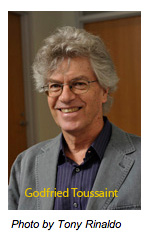 In 1978 Godfried Toussaint announced his intention to write a book on “the art and science of pattern recognition” (the final words of a paper on the use of context in pattern recognition [1]). In 1983 George Nagy used the same expression, but now in an ironic way when he criticized the way pattern recognition results were usually published [2]. In 2005 a symposium in honor of Eric Backer was organized under the same title.
In 1978 Godfried Toussaint announced his intention to write a book on “the art and science of pattern recognition” (the final words of a paper on the use of context in pattern recognition [1]). In 1983 George Nagy used the same expression, but now in an ironic way when he criticized the way pattern recognition results were usually published [2]. In 2005 a symposium in honor of Eric Backer was organized under the same title.Why do some people think that pattern recognition is a science and an art? Godfried Toussaint never wrote the book, George Nagy was not serious and there were no notes from the symposium. If somebody is able to make it clear, it will be Toussaint. He is still (2012) working hard and involved both in science and art. He may once be able to write the book. We have to doubt as he never announced it again. For the time being we can just speculate.
First, pattern recognition is a science as it studies a natural phenomenon, that is generalization. This phenomenon can be observed in almost all humans and perhaps also in some animals. It is the ability to deal with observations of never seen objects and never experienced events in a sensible way. This is based on a recognition of their class and supported by previous observations of other class members (learning from examples).
The science of pattern recognition tries to build models of the learning and recognition process. Four approaches can be distinguished for such studies. The engineering field of pattern recognition makes use of implementations of such models in hardware and by computers. They are used in many places in science and engineering for replacing or supporting human recognition tasks.
But … Where is the art? Well, the recognition of the patterns in music, paintings or literature is a very challenging problem. They are recognized by the listeners, observers and readers. It is not easy at all to characterize them objectively. It is an important application area of Toussaint. Also Backer participated in a number of studies.
Does it make this pattern recognition itself to be an art?
People who have the skill to observe the patterns in pieces of art need to have an art themselves. This art is different from the one of the artist-creator. This has frequently been made clear by novelists and composers criticized by their reviewers. The patterns experienced by the latter can be very different from the ones that are intentionally set by the creators. Still, this doesn’t make reviewers to be scientists as they do not necessarily build models and try to find deeper explanations for the patterns. They don’t have the art of the artist-creator, but they posses the art of recognizing the patterns. For this reason we answer the question with: ‘yes, pattern recognition is, also, an art’.
This reasoning does not stop with the patterns in art. It also holds for observing the patterns in bird songs, in vegetation, in children development, personal growth and so on. One needs a specific skill to see the patterns. This skill may be used by the scientist who studies pattern recognition. He may have the specific art himself, in some domains.
As a human being, however, he has the art for sure in daily life: he can read, recognize people or understand speech. This brings us to the very specific position of pattern recognition under the sciences. It studies a phenomenon, generalization and the recognition of patterns, that he performs himself as an art in some domains. As a scientist he studies the art of pattern recognition as a phenomenon that he can observe in the external world, in other people, but that he is able to realize as well in himself, internally.
This makes the science of pattern recognition special: it is also an art of the scientist, which links pattern recognition to consciousness.
[1] Godfried T. Toussaint, The use of context in pattern recognition, Pattern Recognition, vol. 10, no. 3, pp. 189-204, 1978.
[2] George Nagy, Candide’s Practical Principles of Experimental Pattern Recognition, IEEE Trans. Pattern Anal. Mach. Intell., vol. 5, no. 2,p p. 199-205, 1983.
Filed under: Consciousness • Foundation
